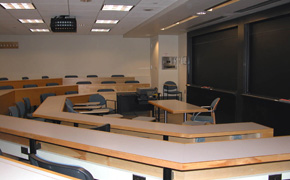This Course at MIT pages are part of the OCW Educator initiative, which seeks to enhance the value of OCW for educators.
This Course at MIT pages provide context for how the course materials published on OCW were used at MIT. They are part of the OCW Educator initiative, which seeks to enhance the value of OCW for educators.
Course Overview
This page focuses on the course ESD.864 Modeling and Assessment for Policy as it was taught by Prof. Noelle Selin in Spring 2013.
Modeling and Assessment for Policy is a graduate course that introduces students to tools and strategies for technically-focused policy analysis. The course is cross-listed with the Department of Earth, Atmospheric, and Planetary Sciences, and draws examples from modeling of earth and environmental systems.
Course Outcomes
Course Goals for Students
- Understand and apply tools and techniques used for technically-focused policy analysis
- Identify best practices and limitations in using quantitative models for policy
- Evaluate the effectiveness of scientific and technical advice in policy-making processes
- Describe and analyze strategies to manage scientific and technical advice processes
- Communicate technical results to policy audiences
Possibilities for Further Study/Careers
- Ongoing research in areas of modeling e.g. science, engineering, economics
- Careers in interpreting scientific results for decision-making
Curriculum Information
Prerequisites
ESD.10 Introduction to Technology and Policy or permission of the instructor
Requirements Satisfied
ESD.864 is a core course for both the Technology and Policy Program and the Graduate Certificate Program in Science, Technology, and Policy. The course can be applied toward a graduate degree in the Engineering Systems Division or the Department of Earth, Atmospheric, and Planetary Sciences, but is not required.
Offered
Every spring semester

Breakdown by Year
Graduate students, including Master’s and PhD candidates
Breakdown by Major
- Half graduate students in Engineering Systems Division
- Half graduate students in other departments, include Civil and Environmental Engineering, Earth, Atmospheric, and Planetary Science, MIT’s Technology and Policy Program, Aeronautics and Astronautics, Writing and Humanistic Studies, and Technology and Operations Management at Harvard Business School
Typical Student Background
An interest in technically-focused policy analysis
During an average week, students were expected to spend 9 hours on the course, roughly divided as follows:
Lecture
- Two class sessions per week, each lasting an hour and a half; 27 sessions total.
- Attendance is mandatory and is reflected in the “Participation” portion of the grading scheme.
Out of Class
Activities such as:
- Readings for class
- Problem sets and other homework
- Group work on the case study project
- Online quizzes throughout the semester
Semester Breakdown
| WEEK | M | T | W | Th | F |
|---|---|---|---|---|---|
| 1 |  |  |  |  |  |
| 2 |  |  |  |  |  |
| 3 |  |  |  |  |  |
| 4 |  |  |  |  |  |
| 5 |  |  |  |  |  |
| 6 |  |  |  |  |  |
| 7 |  |  |  |  |  |
| 8 |  |  |  |  |  |
| 9 |  |  |  |  |  |
| 10 |  |  |  |  |  |
| 11 |  |  |  |  |  |
| 12 |  |  |  |  |  |
| 13 |  |  |  |  |  |
| 14 |  |  |  |  |  |
| 15 |  |  |  |  |  |
| 16 |  |  |  |  |  |
 No classes throughout MIT
No classes throughout MIT Lecture session
Lecture session Class case study
Class case study Assignment due date
Assignment due date No class session scheduled
No class session scheduled Guest lecture
Guest lecture Policy memo roundtable
Policy memo roundtable Quiz due date
Quiz due dateLead Instructor (Prof. Noelle Selin)
Structure and run the course, deliver lectures, design the group activities, work with students and teaching assistants, and provide feedback
Teaching Assistants (Two graduate students)
Support the lead instructor during class sessions; grade the problem sets; interact with students in class, via email and on the class forum; and maintain the course website.


 Room 1 of 1
Room 1 of 1 